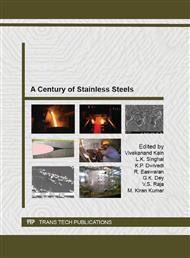[1]
K. H. Lo, C. H. Shek and J. K. L. Lai, Recent Developments in Stainless Steels, Mater. Sci. Engg., R65 (2009) 39-104.
Google Scholar
[2]
F. B. Pickering, Physical Metallurgy and the Design of Steels, Appl. Sci., Publ., London (1978).
Google Scholar
[3]
G. Kirchner, T. Nishizawa, and B. Uhrenius, The Distribution of Chromium Between Ferrite and Austenite and the Thermodynamics of the of Equilibrium in the Fe-Cr and Fe-Mn Systems, Metall. Trans., 4A (1973) 167-174.
DOI: 10.1007/bf02649616
Google Scholar
[4]
J. Andersson and B. Sundman, Thermodynamics properties of the Cr–Fe system, CALPHAD, 11 (1987) 83–92.
DOI: 10.1016/0364-5916(87)90021-6
Google Scholar
[5]
W. A. Dench, Adiabatic high-temperature calorimeter for measurement of heats of alloying, Trans. Faraday Soc., 59 (1963). 1279-1286.
DOI: 10.1039/tf9635901279
Google Scholar
[6]
K. Schroder, Specific Heat of Cr-Fe alloys from -140o to 350o C, Phys. Rev., 125 (1962) 1209– 1212.
Google Scholar
[7]
A. S. Normanton, R. H. Moore and B. B. Argent, A calorimetric and mass spectrometric study of Iron–Chromium alloys, Metal Science, 10 (1976) 207–213.
Google Scholar
[8]
B. J. Lee, J. H. Shim and H. M. Park, A semi empirical atomic potential for Fe – Cr Binary system, CALPHAD, 25 (2001) 527–534.
DOI: 10.1016/s0364-5916(02)00005-6
Google Scholar
[9]
Y. Ustinovshikov, B. Pushkarev, Alloys of the Fe–Cr system: the relations between phase transitions order–disorder and ordering-separation, J. Alloys Compd., 389 (2005) 95-101.
DOI: 10.1016/j.jallcom.2004.07.050
Google Scholar
[10]
W. Xiong, M. Selleby, Q. Chen, J. Odqvist and Y. Du, Phase equilibria and thermodynamics properties in Fe Cr system, Sol. St. Mat. Sci., 35(2010) 125-152.
DOI: 10.1080/10408431003788472
Google Scholar
[11]
W. Xiong, P. Hedstrom, M. Selleby, J. Odqvist, M. Thuvander and Q. Chen, An improved thermodynamics modeling of the Fe–Cr system down to zero Kelvin coupled with key experiments, CALPHAD, 35 (2011) 355–366.
DOI: 10.1016/j.calphad.2011.05.002
Google Scholar
[12]
M. Hennion, Chemical SRO effects in ferromagnetic Fe alloys in relation to electronic band structure, J. Phys. F: Met. Phys. 13 (1983) 235 1-2358.
DOI: 10.1088/0305-4608/13/11/017
Google Scholar
[13]
A. A Mirzoev, M. M. Yalalov and D. A. Mirzaev, Calculation of the Parameters of stability for the Iron- chromium Fcc solid solutions using the results of First principle simulation, The Phys. Met. Metall., 103 (2007) 86-90.
DOI: 10.1134/s0031918x07010115
Google Scholar
[14]
G. Bonny, D. Terentyev, and L. Malerba, On the α-α' miscibility gap of Fe-Cr alloys, Scrip. Mat, 59 (2008) 1193-1196.
DOI: 10.1016/j.scriptamat.2008.08.008
Google Scholar
[15]
G. Bonny., D. Terentyev and L. Malerba, New contribution to the thermodynamics of Fe- Cr alloys as base for ferritic steels, J. Ph. Equlibria & Diff., 31 (2010) 439–444.
DOI: 10.1007/s11669-010-9782-9
Google Scholar
[16]
I. Mirebeau and G. Parette, Neutron study of the short range order inversion in Fe1−xCrx, Phys. Rev., B82 (2010) 104203(1-5).
Google Scholar
[17]
V.I. Razumovskiy, A.V. Ruban, and P.A. Korzhavyi, First-principles study of elastic properties of Cr- and Fe-rich Fe-Cr alloys, Physical Review B 84, 024106 (2011).
DOI: 10.1103/physrevb.84.024106
Google Scholar
[18]
S. M. Dubiel, J. Cieslak, W. Sturhahn, M. Sternik, P. Piekarz, S. Stankov, and K. Parlinski, Vibrational Properties of a and s phases of FeCr, Phys. Rev. Lett., 104(2010) 155503(1-4).
DOI: 10.1103/physrevlett.104.155503
Google Scholar
[19]
A. Caro, D. A. Crowson, M. Caro, Classic Many body potential for concentrated alloys and the inversion of order in Fe–Cr, Phys. Rev. Lett., 95 (2005) 075702 (1-4).
DOI: 10.1103/physrevlett.95.075702
Google Scholar
[20]
A. Hishinuma, S. Takaki and K. Abiko, Recent Progress and Future R&D for High-Chromium Iron-Base and Chromium-Base Alloys Phys. Stat. Solidi, (a)189, (2002) 69–78.
DOI: 10.1002/1521-396x(200201)189:1<69::aid-pssa69>3.0.co;2-9
Google Scholar
[21]
P Olsson, I. A. Abrikosov, L. Vitos and J. Wallenius, Ab Initio formation energies of Fe-Cr alloys, J. Nucl. Mat., 321 (2003) 84–90.
DOI: 10.1016/s0022-3115(03)00207-1
Google Scholar
[22]
H. Zhang, B. Johansson and L. Vitos, Ab initio calculations of elastic properties of bcc Fe–Mg and Fe-Cr random alloys, Phys. Rev. B, 79 (2009) 224201 (1-10).
DOI: 10.1103/physrevb.79.224201
Google Scholar
[23]
M. Y. Lavrentiev, D. Nguyen-Manh and S. L. Dudarev, Cluster expansion models for Fe–Cr alloys the prototype materials for power plant, Comp. Mat. Sci., 49 (2010) 5199–5203.
DOI: 10.1016/j.commatsci.2010.04.033
Google Scholar
[24]
T. Klaver, R. Drautz and M. Finnis, Magnetism and thermodynamics of defect free Fe-Cr alloys, Phys. Rev. B, 74 (2006) 094435 (1-11).
DOI: 10.1103/physrevb.74.094435
Google Scholar
[25]
P. A. Korzhavyi, A. V. Ruban, J. Odqvist J. O. Nilsson and B. Johansson, Electronic structure and effective chemical and magnetic exchange interactions in bcc Fe-Cr alloys, Phys. Rev. B 79 (2009) 054202.
DOI: 10.1103/physrevb.79.054202
Google Scholar
[26]
M. Y. Lavrentiev and H. Mergia, Magnetic cluster expansion simulation and experimental study of high temp magnetic properties of Fe–Cr alloys, J. Phys: Cond. Mat., 24 (2012) 326001.
DOI: 10.1088/0953-8984/24/32/326001
Google Scholar
[27]
B. Fultz, L. Anthony, J. L. Robertson, R. M. Nicklow, S. Spooner, and M. Mostoller, Phys. Rev., B52 (1995) 3280-3285.
DOI: 10.1103/physrevb.52.3280
Google Scholar
[28]
M. S. Lucas, M. Kresch, R. Stevens, and B. Fultz, Phonon partial densities of states and entropies of Fe and Cr in bcc Fe-Cr from inelastic neutron scattering, Phys. Rev., B77 (2008) 184303 (1-5).
DOI: 10.1103/physrevb.77.184303
Google Scholar
[29]
R. L. Klueh, Elevated temperature ferritic and martensitic steels and their application to future nuclear reactors, Int. Mater. Rev., 50 (2005) 287-310.
DOI: 10.2172/885938
Google Scholar
[30]
S. Raju, B. Jeya Ganesh, Arun Kumar Rai, S. Saroja, E. Mohandas, M. Vijayalakshmi and Baldev Raj, Drop Calorimetry Studies on 9Cr–1W–0. 23V–0. 06Ta–0. 09C Reduced Activation Steel, Int. J. Thermophys., 31 (2010) 399-415.
DOI: 10.1007/s10765-010-0720-1
Google Scholar
[31]
M. Hillert and M. Jarl, A model for alloying effect in ferromagnetic metals, CALPHAD, 2 (1978) 227-238.
DOI: 10.1016/0364-5916(78)90011-1
Google Scholar
[32]
A. Dinsdale, SGTE data for pure elements, CALPHAD, 15 (1991) 317-425.
DOI: 10.1016/0364-5916(91)90030-n
Google Scholar


